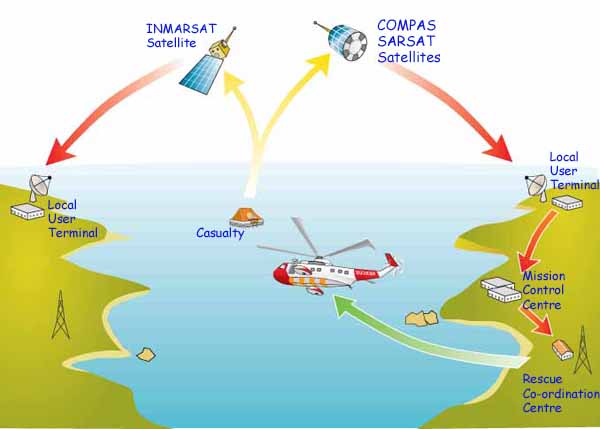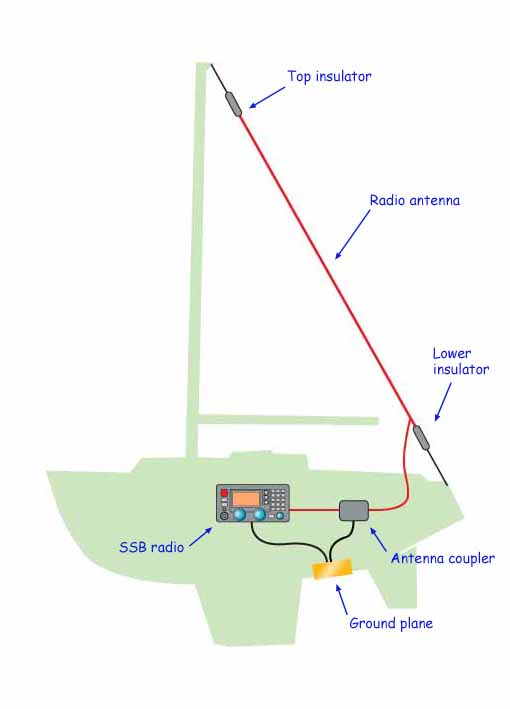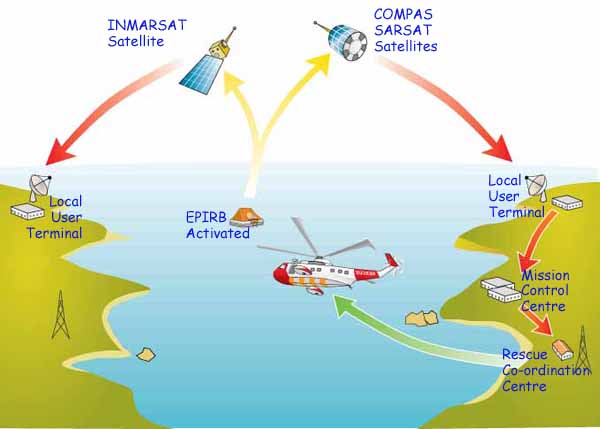- Home
- Electronics & Instrumentation
- DSC Radio
DSC Radio and Pushbutton Distress Calls
All fixed VHF radios produced today have DSC radio (Digital Selective Calling) functionality built in as standard. Prior to the advent of DSC equipped VHF radios, all VHF communication was limited to open-channel voice traffic.
 DSC Radio is a part of the Global Maritime Distress and Safety System (GMDSS)
DSC Radio is a part of the Global Maritime Distress and Safety System (GMDSS)Everyone could eavesdrop on your conversations, and distress calls could go unanswered due to the widespread misuse of channel 16.
All this changed with the arrival of the Global Maritime Distress and Safety System (GMDSS) and the DSC VHF radio.
DSC uses VHF channel 70 to transmit and receive digital messages.
No voice communication is permitted on that channel; it's reserved solely for DSC which enables you to selectively contact other stations and in digital format (an MMSI number), or nominate another channel for voice communication.
DSC Radio and MMSI
In the UK, Maritime Mobile Service Identity (MMSI) numbers are assigned as a part of the ship's radio licensing procedure. These nine digits number are used to uniquely identify a radio station.
The MMSI number has a standard format and identifies the type of station, country of registration and vessel identity, and can be programmed into a DSC equipped VHF radio just like entering a number into a mobile phone.
Alternatively, groups of MMSI's can be programmed in, effectively creating a net to which communal broadcasts can be made.
Here's how to
Distress Calls and DSC Radio
But by far the most important feature of DSC is that it provides a safer way of placing a distress call to the coastguard.
A DSC distress message includes all the vital information required by the authorities - MMSI, current position and time of call - to initiate a rescue mission.

Sending a distress message is as simple as selecting the nature of the distress from a scroll-down list on screen and pressing the distress button, dramatically improving the chance of a successful message than a MAYDAY call on channel 16.
If the VHF set is interfaced with the GPS, then the position information is fully automated; otherwise it must be entered manually.
Handheld DSC VHF Radio
It had to come of course; handheld VHF radios with both DSC and GPS built in.

If you're unlucky enough to have to take to your liferaft, then one of these will greatly increase your chances of early rescue.
Predictably perhaps, they're not cheap...
Any Questions?
What are the benefits of using marine DSC radio?
What are the benefits of using marine DSC radio?
Marine DSC radio has several advantages over traditional voice communication, such as:
- It can transmit data digitally, which means it has a longer range, faster speed and clearer quality than analog signals;
- It can send a distress alert with a single button press, which includes your vessel's identity, position and time. This can save precious time and provide accurate information to rescuers in an emergency;
- It can make ship-to-ship calls using a unique 9-digit code called Maritime Mobile Service Identity (MMSI), which allows you to contact a specific vessel without broadcasting over an open channel;
- It can scan multiple channels for distress, urgency and safety messages, and alert you when a message is received.
How do I get a marine DSC radio?
How do I get a marine DSC radio?
All new VHF radios sold in the market are equipped with DSC capabilities. You can also buy MF/HF radios that have DSC functions. However, before you use a marine DSC radio, you need to register for a MMSI number and program it into your radio.
How do I register for a MMSI number?
How do I register for a MMSI number?
You can obtain a MMSI number from various organizations, such as the Federal Communications Commission (FCC), Boat US, Sea Tow, the Power Squadron, and Shine Micro. The registration process may vary depending on the organization, but generally you need to provide some basic information about your vessel, such as its name, type, size, colour, owner and contact details. You also need to specify the type of radio equipment you have on board and the areas where you operate.
What is the difference between FCC and non-FCC MMSI numbers?
What is the difference between FCC and non-FCC MMSI numbers?
FCC MMSI numbers are valid worldwide and are entered into an international database. Non-FCC MMSI numbers are only valid in the US and are entered into a national database. If you plan to travel outside the US waters, you need to have an FCC MMSI number. Otherwise, you can use a non-FCC MMSI number.
How do I program my MMSI number into my radio?
How do I program my MMSI number into my radio?
The procedure for programming your MMSI number into your radio may differ depending on the model and manufacturer of your radio. You should consult your radio's manual for specific instructions. However, in general, you need to access the menu or setup mode of your radio, select the option for entering or editing your MMSI number, enter the 9-digit code using the keypad or buttons, and confirm or save your entry.
What is the range of marine DSC radio?
What is the range of marine DSC radio?
The range of marine DSC radio depends on several factors, such as the transmission power, the frequency band, the antenna height, the weather conditions and the terrain. In general, marine DSC radio has a longer range than traditional voice communication, with up to 25% more distance and faster speed.
For VHF DSC radio, the transmission power ranges between 1 and 25 watts, giving a maximum range of up to about 60 nautical miles between aerials mounted on tall ships and hills, and 5 nautical miles between aerials mounted on small boats at sea level.
For MF/HF DSC radio, the transmission power ranges between 60 and 150 watts, giving a maximum range of up to several thousand nautical miles depending on the frequency band and the atmospheric conditions. MF/HF DSC radio monitors multiple distress, urgency and safety bands in the 2, 4, 6, 8, 12 and 16 MHz bands.
How do I send a distress alert using marine DSC radio?
How do I send a distress alert using marine DSC radio?
To send a distress alert using marine DSC radio, you need to press and hold the red distress button on your radio for at least 5 seconds. This will automatically send a digital message containing your MMSI number, position and time to all nearby vessels and coast stations on channel 70 (VHF) or 2187.5 kHz (MF/HF). You should also switch to channel 16 (VHF) or 2182 kHz (MF/HF) and make a voice mayday call following the standard procedure.
How do I make a ship-to-ship call using marine DSC radio?
How do I make a ship-to-ship call using marine DSC radio?
To make a ship-to-ship call using marine DSC radio, you need to know the MMSI number of the vessel you want to contact. You can either enter it manually using the keypad or buttons on your radio, or select it from a stored list if your radio has that feature. Then you need to choose a working channel where you want to have the voice conversation. After that, you need to press the call button on your radio, which will send a digital request to the other vessel on channel 70 (VHF) or one of the MF/HF calling frequencies. If the other vessel accepts your request, both radios will automatically switch to the working channel and you can start talking.
How do I receive a call using marine DSC radio?
How do I receive a call using marine DSC radio?
To receive a call using marine DSC radio, you need to have your radio turned on and set to scan mode. This means that your radio will monitor channel 70 (VHF) or multiple MF/HF calling frequencies for incoming digital messages. When someone calls you, your radio will alert you with a sound or a display. You can then accept or reject the call using the buttons on your radio. If you accept the call, your radio will automatically switch to the working channel where you can have the voice conversation.
How do I test my marine DSC radio?
How do I test my marine DSC radio?
To test your marine DSC radio, you can perform a self-test or a test call. A self-test is a function that allows you to check the internal operation of your radio. You can access it from the menu or setup mode of your radio. A test call is a function that allows you to check the transmission and reception of your radio. You can make a test call to another vessel or a coast station that has DSC capabilities. You need to enter their MMSI number and select a test category, such as routine, position or distress. Then you need to press the call button on your radio, which will send a digital message to the other party. If they receive your message, they will send back an acknowledgment, which will confirm that your radio is working properly.
The above answers were drafted by sailboat-cruising.com using GPT-4 (OpenAI’s large-scale language-generation model) as a research assistant to develop source material; to the best of our knowledge, we believe them to be accurate.
Recent Articles
-
Wauquiez Gladiateur 33 for Sale
Apr 10, 24 05:40 AM
'Kesh', my Wauquiez Gladiateur 33 is only for sale because we've decided to go for a larger sailboat. She currently berthed in Florida, USA. -
'Cabo Frio', a Catalina Morgan 43 for sale
Apr 01, 24 08:35 AM
This Catalina Morgan 43 is for sale at a very reasonable price. She offers up to 7 berths in 2 cabins + saloon. There is full 6'5" standing headroom and good ventilation throughout. -
Live Aboard Boats For Sale
Mar 30, 24 07:02 PM
Ready to live the dream? Then browsing through this listing of live aboard boats for sale might just get you on your way...















